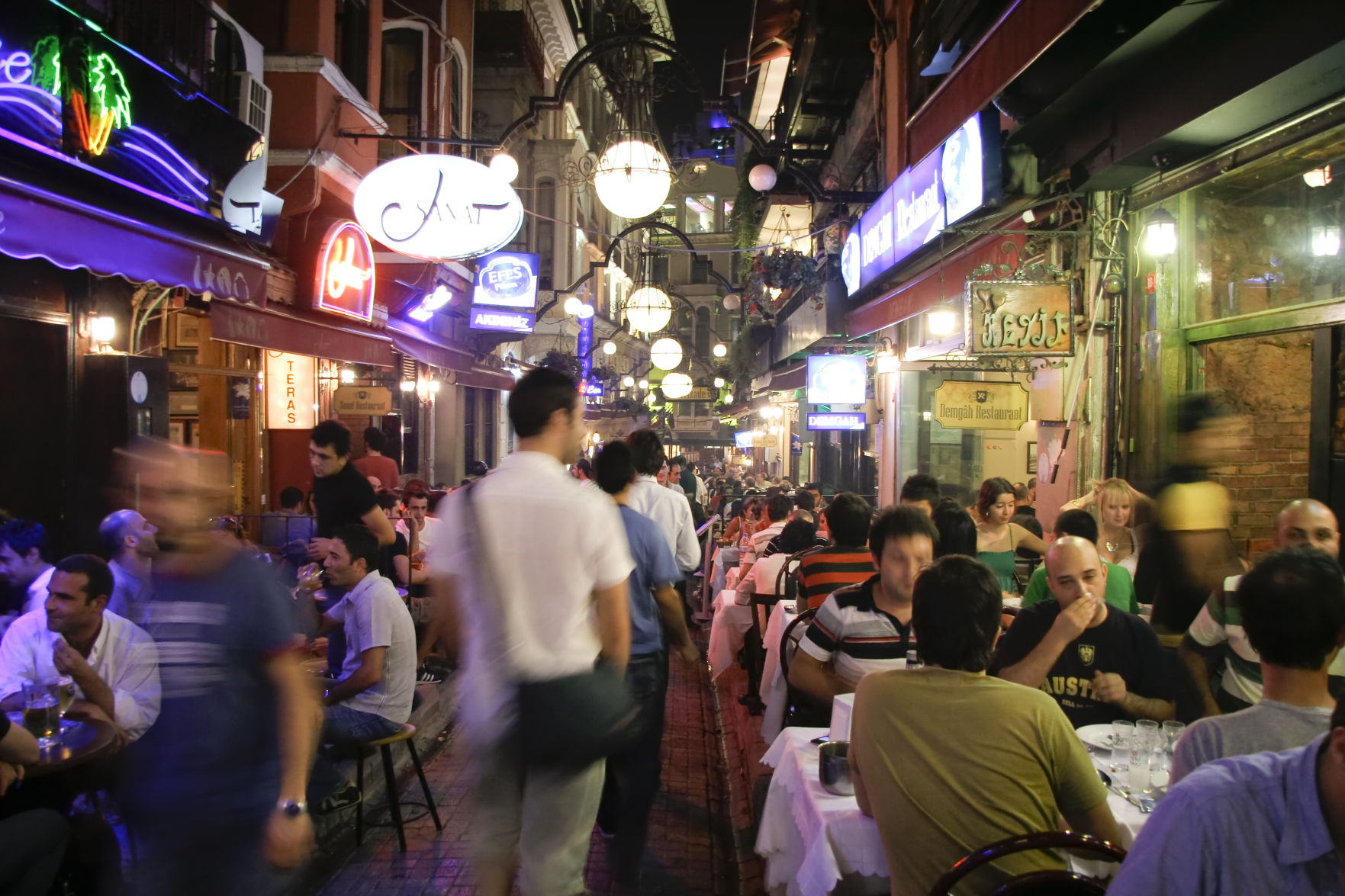It’s noisy in here. It sounds like a thousand Fran Dreschers karaoking on the wing of an airborne jet. Both my dining companion and I are leaning toward each other, talking at a volume reserved for angry Italian siblings. Aural vertigo begins to set in, the room starting to wobble in sync with my inner ear.
I’ve considered the fact that maybe I’m getting old. Maybe I’ll go home and yell at some kid to get off my lawn. But, no, this is a real problem. The rest of the diners are all yell-talking.
“Welcome to Hip Bistro X, we have a wonderful table for you by the bar. Here are your menus and earplugs. Enjoy!”
Dinner has become a rock concert. And here’s why.
Restaurant design is hard. Literally. Owners are asking for the hip design materials of for this post-industrial moment—concrete, steel, reclaimed wood, glass, exposed air conditioned ducts that act like a shaky, hollow, homemade instrument for a moonshiner jug band. Soft materials are out. Carpet is what your parents’ steakhouse had. Not cool. Soft leather seats are in Denny’s, not this hip joint. And white tablecloths? You erudite prude.
What happens when you throw a loud noise at a hard surface? It bounces back even harder. It’s the Marshall stack of noise. It’s like when Jimi Hendrix put his guitar next to the amp and made all that crazy, loud music.
Windows are hard. High ceilings in a cavernous warehouse space with a roll-up garage door that lets the sonata of the street flood into the space? Congratulations, you just turned a restaurant into an echo chamber. You’ve got an open kitchen, too? There is nothing silent or zen about restaurant kitchens.
In ye olden days, the bar used to be separated or off in the back, away from the dining room. Now, “social dining” is the name of the game. The bar is the centerpiece of most restaurants. I don’t know much. But I do know that when you add alcohol to a human, the human gets louder. In our effort to make dining fun, we’ve also made it deafening.
For more insight, I called Matthew Ellis. Matt is the owner and designer behind Bluemotif Architecture, who’s designed some of the city’s top restaurants, including Cowboy Star, Juniper & Ivy and Kettner Exchange.
Why’s it so loud, man?
I don’t think enough designers are thinking about it during the design process. You work hard to get a place open and go, ‘Oh, shit. It’s really loud in here.’ So we have to work extra hard to offset the acoustics.
Pandora’s box?
With new sound systems you can put speakers everywhere. Some operators really want that vibe, crank it up and create a lounge scene. They want to break that barrier and threshold between restaurant and bar.
What about the trend of indoor-outdoor dining? Blowing out walls and making the restaurant part of the street?
San Diego is known for its friendly outdoor climate, but creating a comfortable outdoor dining environment can be tricky. It’s a difficult balance, especially if you’re located near a major intersection. You’ve got the traffic, the brakes squeaking, street musicians competing for attention, planes flying overhead (in Little Italy), etc…. When you’re designing a place that demands intimacy but still provides interactivity w/ the urban environment, you’re trying to control that noise. It’s a delicate balance of designing an envelope to buffer and keep environmental noise out while also attempting to dampen “noise” from within while also maintaining enough background chatter that the environment doesn’t feel dead (nothing kills a vibe more than deathly library silence). To add a layer of complexity, sometimes, opening the envelope of the building (cracking open a door or window can help alleviate interior “noise”, but in an urban environment where residents live next to our local drinking habits, we also have to find strategies to minimize the negative impact the “noise” escaping from a restaurant has on it’s neighbors.
What about server stations—those seem like drum kits.
Yeah. You have to be mindful of where you place server stations. No one likes to sit next to a bunch of clankety tin and glassware, but even that can be mitigated with the correct acoustic attenuation.
Talk to me.
One of the things that’ll kill the acoustics in a space are big, plate-glass windows. They reflect sound, and they do so in a way that’s not consistent. Add to that hard floors, hard ceilings, and hard, vertical walls. We’ve found you can have big windows, but if you place them at a slight angle, it helps break up the sound. Sometimes opening windows to the outside environmental noise is better than keeping the windows closed to avoid a lot of sound reverberation.
Reclaimed wood is the current restaurant material Jesus. Is wood loud?
Wood is not a bad material for absorption. It attenuates better than drywall. Soft woods and wood surfaces with heavier irregularity dampen sound better than hard woods with clean refined finishes.
What project of yours was a challenge, and how’d you handle it?
Catania in La Jolla was a challenge to control interior sound. That little space was super challenging. Concrete floor, concrete ceiling and four walls of glass (which we wanted to take in that awesome view). The ceiling was very low and made of concrete. We wanted wood floors to soften the noise, but the client really wanted concrete for cost and maintenance reasons. So we put in acoustic attenuation on the ceilings. It does such a great job. It’s dark and disappears from view and doesn’t create a distraction that pulls your eyes away from that amazing view. We also used a cork paneling on the walls which complemented the olive wood veneers. Green Acre in La Jolla was a challenge to control the outdoor environmental sound. Every few minutes, jets from Miramar race by and shake the foundation of the building. That was a really big issue, especially since the entire concept was based on pulling the canyon into the space and connecting to the natural outdoor environment. We used a really dense material that looks like panels of Triscuit Crackers. It absorbs and dampens sound from the outside before it rattles the patrons eardrums – cool product.
Roll-up garage doors look cool. How are they for sound?
Horrible. Not only are they really thin and made up of a bunch of aluminum and glass panels, but they’re meant to move and fold. They have a lot of joints. They reflect a ton of noise and leak a lot of noise.
Would carpet help?
Carpet is GREAT for acoustics, but carpet is just nasty in restaurants. One great night of service = blood stains, beer spills, and food fights which leave their wear (stains and yeasty odors). We have a project that we’re using a cork flooring. Cork is really great for sound but it looks like regular wood flooring.
What about people?
People are actually some of the best absorbers of sound … because we’re basically just big bags of water.
Open kitchens?
You have a couple choices. You can put glass up, but then it becomes a sound reflector. Or you can leave it open, and then risk the pots and pans and the sound of the whisks.
What’s the hardest external noise element?
Restaurants near hospitals. The ambulances come screaming by with sirens. You just can’t make that sexy.
Does shape of the room matter?
Shape and proportion matter. Flat, orthogonal, perpendicular, regular surfaces are every acoustician’s enemy – It has to do with the wall height and width ratios. If you have a very square room or a cube, the sound can be horrible. But if you have more volume in that space, sometimes it’s not that bad because the sound can bounce around and deflect up high, above the zone where it can be detected.
What about brick?
Although brick is a relatively hard surface, a brick wall has a lot of irregularity which can help a great deal in sound attenuation.
So now you can see—the hard design elements en vogue and the big, open, square spaces are why your ears hurt. Restaurant noise is the new MSG, leaving diners wondering why their temples are throbbing.
Restaurant owners, I plead with you. Put some soft stuff in there. Angle a window. Use cork or brick or “attenuation material.” Having soft material in your new, hip restaurant does not mean you love Kenny G. You do not have to drive a LeBaron. It does not prevent you from attending Coachella.
Before you open your restaurant, invite tons of friends into your restaurant and get them drunk. The volume of drunk people goes to 11. Physically install panels while they’re in there.
Tinnitus should not be a dinner option.

PARTNER CONTENT
The Noisy Restaurant Epidemic
















